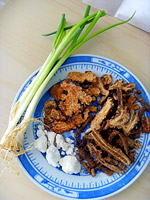|
Traditional Chinese medicine (TCM) is an ancient form of medicine. During the thousand years of clinical practice, it has not only accumulated extensive experience in dealing with diseases, but also created various treatment modalities to help achieve optimal clinical results. Herbal remedies are often taken orally, however external applications are popular too. With delivery techniques like dressing, pasting, rubbing, fumigating or washing, active ingredients in herbs can infiltrate through the skin, enter into the blood stream and then travel to the entire body. It should be noted that TCM external applications are under the guidance of TCM theories, which are designed according to syndrome differentiation. For external herbal remedies, TCM physicians like to prescribe raw herbs, herbs in strong properties or fragrant herbs, which facilitate their effects to be absorbed through skin. The preparation forms and applying body regions also play important roles in ensuring the efficacy.
Headaches are common ailments found in everyday life. Headaches vary in intensity, frequency and duration depending upon the types and how people are sensitive to them. Headache management should be tailored made to individual conditions. It is not uncommon for people to try a variety of methods before finding the most suitable one. TCM uses complementary and integrative approach to manage headaches, some external herbal applications are listed as follows.
Medicinal hot compress to relieve headaches
This was called "hot ironing therapy" in ancient times, which involves applying a hot compress over the body surface and with techniques like pushing, rubbing and pressing for treating diseases. TCM claims that the therapy stimulates the communication of the striae, regulates the meridians and promotes the flow of blood and qi. Medicinal hot compress is effective for conditions caused by excessive cold or dampness pathogens, qi stagnation, blood stasis, and weakened organs.
There are two ways to compress: either using a wet cloth soaked with herbal decoction or using a dry herbal pack. For a dry compress, first choose a prescription according to individual condition, grind the ingredients slightly, place in a cloth bag and bind up tightly, then heat up the herbal pack and use it to press, push or rub the area to be treated. For a web compress, decoct the herbs and use a folded piece of material, bandage or small towel, to soak up the warm solution, and then place over the area for a period of time. Replace with a new compress as soon as it has cooled to body temperature. The web compress is often used as a prelude to massage therapy.
Medicinal hot compress for headaches
 |
 |
| Atractylodes rhizome,
notopterygium root,
processed alum and
green onion stalks |
Atractylodes rhizome (30g), notopterygium root (30g), processed alum (10g), and fresh green onion stalk (15g). Pound and mix the first three ingredients, fry to heat up, add in the fresh green onion and pound slightly, place the mixture in a cloth bag and bind up tightly, then put the herbal pack on the belly button and cover it with both hands. Apply for 20 minutes, once a day. |
 |
Angelica root, Sichuan lovage, Dahurian angelica root, dried tangerine peel, atractylodes rhizome, magnolia bark, pinellia tuber, ephedra, bitter orange and platycodon root, prepare 20g for each. Dried ginger, cassia twig and medicinal evodia fruits, 10g for each; and liquorice root 5g. Grind the ingredients slightly, place in a cloth bag and heat it up. Use the hot compress to press the head and neck, and the sides of upper backbone, back and forth for 20-30 minutes, then leave it on the belly button for 20 minutes. Reheat the compress when it has cooled. Apply once a day. |
|